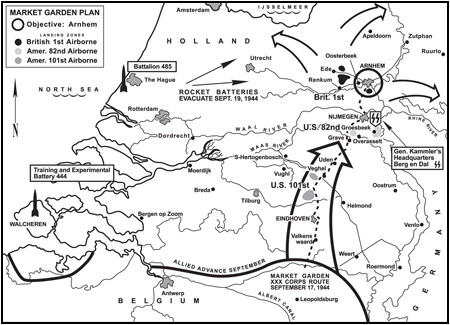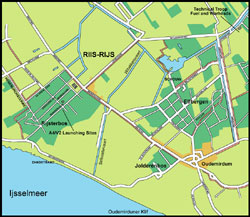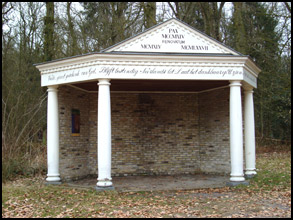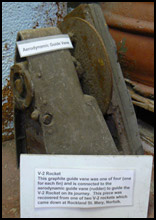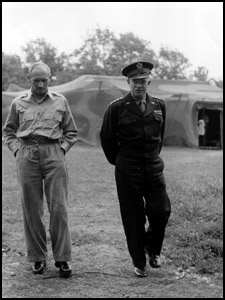V2ROCKET.COM Experimental Battery 444) in Walcheren and Rijs (original) (raw)
| Serooskerke/Walcheren After being transferred from Gruppe S�d to Gruppe Nord, Lehr und Versuchsbatterie 444 (Training and Experimental Battery 444) moved from Houffalize in Belgium to Walcheren on the Dutch coast during the days of September 10-15, 1944. Traveling via Germany, the trucks entered Holland at Nijmegen, then via Den Bosch to Breda - via Bergen op Zoom, then to Walcheren, where they arrived on September 15 (after Engineering Battalion 211 had repaired the damage to roads at Rilland). Battalion 3 Technical Abteilung 91 was soon added to the forces of Battery 444 at Walcheren. The rockets were brought to the area from the Bevelanden Causeway, through Middleburg to Ter Hooge, where they were temporarily stored on trailers under the trees. Castle Ter Hooge was the home for the commander of the German Division Headquarters at Walcheren and Bevelanden (General-Lieutenant Wilhelm Daser).�PRO AIR.37/1253 The chosen launching site for the rocket operations in Walcheren would be the small town of Serooskerke. During the WWII occupation of Walcheren, not much was different for the citizens of Serooskerke. Little of the war was noticed in the town. Of course German troops were in or near the town�and also work must be performed for the Germans�but life goes on almost at a normal pace. However, residents described how on Friday, September 15, two German officers reported to the city municipality saying that citizens must open their windows the next day because of "shootings with heavy guns" and to stay away from the windows, as this air pressure change might break the glass. | 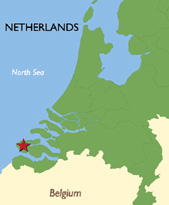 |
|---|
Battery 444 firing troops soon occupied the grounds of the estate named Vrederust (now Welgelegen). Residents owning homes near the park were evacuated from the vicinity. The grounds of the estate were sealed off from eyes of civilians and heavy camouflage nets were erected. The estate had been occupied by German soldiers since 1942 and featured several large concrete and earth air raid shelters, which were used as cover by the rocket soldiers during the launches. Two small launching areas, each about 25 feet in diameter, were cleared out among the 70 foot-tall beech trees near the house (at this time Battery 444 had only two firing tables). One site was about 200 yards south from the house, while the other was only 30 yards to the east. Civilian eyewitnesses reported that the rocket operations were carried out by a group of about 70 German soldiers. �PRO AIR.37/1253
Built in1894, the estate and park Vrederust had been commissioned by Maria Wilhelmina van Vollenhoven, who was the daughter of a prominent mayor of Amsterdam. A large villa was built, along with coach house and gardens. The villa interior featured stucco ceilings and stained-glass windows from the Delft Prinsenhof studio. When the V-2 troops arrived at Vrederust there was difficulty because of the tight turn�due to the length of the rockets and trailers. So the original pillars of the elegant entrance gate were demolished to make way for the rockets to enter. �Collier, Basil. The Battle of the V-Weapons
The next morning at about 07:30 AM the residents of Serooskerke were shaken from their sleep as the first rocket lifted off heading over the English Channel. Reportedly, an RAF aircraft flew low over the town at about the same time and it was obvious the pilot had seen the launch. The citizens had barely recovered from their shock when a second rocket was launched from Buitenplaats Vrederust around 8:15 AM. They watched the rocket rise and turn to the west, again heading for England. These two rockets impacted Southgate and Wembley respectively, causing the deaths of 16 and injuring 23 others. In the town it was rumored that another V-2 would lift off later that same afternoon. �Bosse, P.G. v.d., Diary of M.Sturm in Serooskerke
Jos de Ligny was the 17 year-old daughter of local blacksmith J.A. de Ligny. Jos owned an AGFA box-camera and was a budding amateur photographer. Weeks before, she had been approached by the local resistance asking if shewas willing to take photographs of German positions and defenses that could be passed on to the Allies. She was notafraid�she was excited. She proceeded to travel around Walcheren taking photos of German positions such as Domburg and Oostkapelle. After the twoV-2 launches from Vrederust that morning, Jos decided get a glimpse of the rocket operations. Even though the launching area was well sealed off, youngsters knew where to go. From a goat stable on adjacent property she found a good view of the launch location and shot two whole rolls of film that were passed to the resistance that evening. Presumably, these photos showed launch site vehicles and ground preparations. �Bevrijdingsmuseum Zeeland
The next morning, Sunday, September 17, the third V-2 is launched around 06:30 AM. Hoping to take more photographs, Jos grabbed her camera and made her way with caution to Dr. Reynders Schilt's house, which had a good view situated on a corner. At 07:00 AM another V-2 is launched and Jos was able to take photos of the rocket launching and climbing into the sky.

The following day, Monday, September 18, Jos was at home with her brother Bram, who was sick in bedwith tuberculosis in the family room. Bram called to Jos to come quickly with her camera. In the street directly in front of their house was a Meillerwagen trailer holding a V-2 rocket. The driver of the towing vehicle was supposed to drive to Vrederust via Vrouwenpolderseweg then Torenstraat but the driver accidentally turned left into Noordweg at the church. Running upstairs, Jos was able to take a photo through the curtains of her bedroom window. Having difficulty maneuvering the tiny streets, the driver turns in front of the church (Johanneskerke). Her brother Bram took the camera and hurried to their neighbor's house to get a second photo of the rocket maneuvering in the street. Afterwards, Jos discovered there were six unused frames on the film roll. She decided use up the remaining film by taking shots of the house, garden and kitchen, then delivered the roll to local photographer named Broerse. As Broerse began developing the negatives he sees the images of the V-2 rocket among the other family photos and says, "Never bring such images to me again!" �Bevrijdingsmuseum Zeeland

Photos below: Views of the V-2 and Meillerwagen taken by Jos and her brother. The aerial shows the location in Serooskerke.
 |
 |
 |
 |
 |
 |
|---|---|---|---|---|---|
 |
 |
 |
 |
 |
 |

On September 19, 1944 SS General Kammler, fearing the unit might be overrun by Allied Troops during "Market Garden," ordered the Battery 444 to proceed north to Gaasterland. Little else is known about the secret V-2 activities at Serooskerke because of the very limited operational period. Battery 444 launched 6 rockets towards London on the days of September 16-18, 1944. Of the six, only three reached England. Two more rockets failed to ignite and were taken down and sent back for repairs. �Division z.V. War Diary
After the troops were gone Jos de Ligny still had a few rolls of undeveloped film and the two prints of the V-2 and Meillerwagen in the streets of Serooskerke. On 12 November 1944 a British RAF officer arrived in Serooskerke to inquire about the rocket launches. Jos handed over all of her film and photos to the officer who took them back to England. A month later athank-you letter from the British Air Ministry was delivered to Jos by another officer. Inside were copies of the two prints from September 18. These are the only two surviving photos from Serooskerkerocket attacks existing today. The whereabouts of the undeveloped film rolls showing the V-2 in flight, and the other film previously given to the resistance, remains a mystery to this day. Thecamera and complete dossier belonging to Jos de Ligny are now included in the collection of the Liberation Museum Zeeland. Jos de Ligny passed away on 05 Jan. 2017 at the age of 89. �Irving, David. The Mare's Nest �Bevrijdingsmuseum Zeeland
5th December 1944
Dear Madam,
I have received copies of, two photographs of the German Long Range Rocket V-2, which I understand you took from your house in Walcheren and I have much pleasure in enclosing copies for your retention.
I am directed to offer you, on behalf of the Royal Air Force, the most sincere thanks for allowing us to have these valuable photographs. I should like to say that your courageous action in taking the photographs, and keeping the negatives for us, has inspired general admiration and your action is most warmly appreciated.
The photographs have been of great value to my department in combating this weapon and I should like personally to add my thanks and congratulations and to tell you how much we all look forward to the complete liberation of your brave country, which I trust may be accomplished soon.
Your Obedient Servant,
Roland Eugene Vintras Air Commodore, Royal Air Force

**Timeline V-2 attacks from Serooskerke 16-18 Sept. 1944
Sept. 16, (07.32 hours) - Battery 444, Walcheren, Serooskerke, Vrederust, V-2 rocket fired, impacted Southgate. Direct hit on house. 16 Dead, 22 seriously injured.
Sept. 16, (08.21 hours) - Battery 444, Walcheren, Serooskerke, Vrederust, V-2 rocket fired, impacted Wembley. 1 Person injured. (John Pridige)
Sept. 17, (+/- 06.30 hours) - Battery 444, Walcheren, Serooskerke, Vrederust, V-2 rocket fired, (impact unknown.) (John Pridige)
Sept. 17, (+/- 07.00 hours) - Battery 444, Walcheren, Serooskerke, Vrederust, V-2 rocket fired, impacted East Ham. Direct hit on houses. 6 Dead, 15 seriously injured. (John Pridige)
Sept. 17, (+/- 19.52 hours) - Battery 444, Walcheren, Serooskerke, Vrederust, V-2 rocket fired, impacted Lewisham. 14 Dead, 41 seriously injured. 7 Houses demolished. (John Pridige)
Sept. 18, (+/- 20.00 hours) -Battery 444, Walcheren, Serooskerke, Vrederust, V-2 rocket fired, impacted Lambeth. Direct hit on Chatsworth Chapel. 2 Dead, 36 seriously injured. (John Pridige)

**Photos Launching Site Vrederust (Welgelegen) Photos: Ed Straten (2018)
 |
 |
 |
 |
 |
 |
|---|---|---|---|---|---|
 |
 |
 |
 |
 |
 |
 |
 |
 |
 |
 |
 |


Special thanks to Ed Straten, Niels Koops, and Hans Houterman.

| Rijs/Gaasterland On September 09, 1944 the staff at British Field Marshal Bernard Montgomery�s headquarters received an urgent message from the Vice Chief of the Imperial General Staff: �Two rockets, so called V-2, landed in England yesterday. Please report most urgently by what approximate date you consider you can rope off the coastal area contained by Antwerp-Utrecht-Rotterdam. When this area is in our hands the threat from this weapon will probably have dispersed.� �Longmate, Hitler�s Rockets: The Story of the V-2s On September 10, 1944, Supreme Allied Commander General Eisenhower flew to Brussels for a meeting with Field Marshal Montgomery. It was a trip he was not looking forward to. He did not think highly of the egotistic British field marshal who had been openly critical of Eisenhower�s �broad front� strategy. Even while the Allied advance was grinding to a halt, Montgomery had been proposing what he called his �single thrust plan,� an idea for a powerful thrust into Holland that would trap German forces in the Ruhr and allow the Allies to drive straight to Berlin, ending the war before Christmas. Eisenhower had heard this proposal before; he had rejected it several times already. Eisenhower believed the best way to get the Allied advance underway again was to open the Belgian port of Antwerp. If the estuary could be cleared, and the remaining resistance eliminated, the deep-water harbor would allow the necessary supplies to quickly reach the front lines. Eisenhower believed enormous stockpiles would need to be built up prior to the commencement of a long drive across the German heartland. | 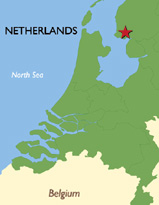 |
|---|
Eisenhower�s meeting with Montgomery started off just as he had expected; the Field Marshal began lambasting the current Allied strategy and came up with all the same criticisms and optimistic proposals. Montgomery insisted if he received all the men and equipment he requested, he could capture a bridge over the Rhine and be in Berlin in less than three months. However, this time the British field marshal offered a different argument. Montgomery pointed out that the German rocket campaign had begun and that British Intelligence knew the rockets were being launched from somewhere on the Dutch coast. If the plan worked, not only would it be a catalyst into Germany but it would also counteract the V-2 threat. Holland had been under German occupation for four years, and the British commander believed that the German forces there were weak. If airborne units could land and hold key bridges, he could send a heavy armored force racing through Holland all the way to the IJsselmeer. This time Eisenhower agreed to the plan. Even though he was doubtful as to whether the operation would swiftly facilitate a passageway into Germany, the prospect of capturing a bridge over the Rhine, while at the same time reducing the rocket threat, must have appealed to him. Code-named Operation Market Garden, it would be the largest airborne drop in military history. Three Allied divisions would be involved. In the �Market� portion of the plan, the U.S. 101st Airborne Division Airborne would drop near Eindhoven and secure the canal crossings at Veghel. The U.S. 82nd Airborne Division would capture the bridges over the Maas River at Grave and the Waal River at Nijmegen. Sixty miles behind German lines, the British First Airborne, then later the Polish First Airborne Brigade, would be dropped on the bridge over the Rhine River at Arnhem. In the �Garden� phase, British XXX Corps would dash up these Allied-held river crossings to relieve the First Airborne at Arnhem.
On September 19, 1944, at the beginning of the Allied airborne landings, SS General Kammler ordered the evacuation of all rocket troops from The Hague and Walcheren, for fear they might be cut off. The inhabitants of Wassenaar were able return to their homes after Battalion 485 withdrew from the area under the cover of darkness. The vehicles of the first battery traveled north and arrived at Overveen near Haarlem and then retreated all the way into Germany in Burgsteinfurt, where they were joined later by the second battery. The first battery of 485 set up operations west of the small town of Legden with two firing sites at Beikelort where they launched a total of 21 rockets from September 21 to October 08 against continental targets such as Louvain, Tournai, Maastricht, and Li�ge. At the beginning of Market Garden, American forces almost nabbed General Kammler at Berg en Dal, so he moved his headquarters to the German town of Darfeld in Burgsteinfurt for a short time. But after moving again to Ludenscheid on September 21, he soon established a permanent headquarters in Germany, east of Dortmund at Suttrop bei Warstein on October 03. �BAMA RH 26.1022/3, Division z.V. War Diary
It is often reported that Kammler�s headquarters was located for a time in the Dutch town of Haaksbergen. In fact, there was no German headquarters of any kind at Haaksbergen. It may have been confusion between the names Haaksbergen and Schaarsbergen. Schaarsbergen was about 20 kilometers from Apeldoorn, and many German barracks were concentrated in this area. Dornberger and Kammler reportedly met on several occasions at a location near Apeldoorn. �Cor Lulof, 2004
After spending only a few days at Walcheren, Training and Experimental Battery 444 traveled north to Gaasterland in southwest Friesland, where it could continue operations against England. The fact that General Kammler did not withdraw the Battery 444 to Germany was probably that he wanted to show the Allied High Command that his units were still able to hit Britain with V-2s. On September 18-19, together with the 3./Technische Abteilung 91 (technical support troops), the rocket troops traveled under the cover of darkness, as it was very risky to be on the roads during daylight hours because of Allied air superiority. Heading through Bergen op Zoom to cross the Maas River at Dordrecht, they journeyed via De Bilt, Zwolle and Heerenveen, arriving at their destination on September 23, 1944. After arriving in Friesland, they set up operations in a small forested area called Rijs, south of the city of Balk. The Rijsterbos (Rijster Forest) was just off the waters of the IJsselmeer (Zuider Zee), a huge shallow lake in the center of Holland. �Henk Koopman 2017

| Moving by train, the rockets earmarked for Battery 444 left the Assen railway station bound for the town of Heerenveen. At Heerenveen station the rockets were placed on Vidalwagen road transport trailers of the supply troops and then towed by truck into Balk using the route was via St.Nicolaasga, Sloten, Balk, Raadhuisbridge van Swinderenstraat,Houtdyk on to Kippenburg. The transport of the rockets on Vidalwagens took place as soon as darkness had fallen. On the evening of September 23, 1944, Dutch residents witnessed many vehicles and rockets parked beside City Hall in Balk. From Balk a sharp turn to the right had to be made to get to the van Swinderenstraat in the direction of Kippenburg, which was near the firing sites. The rocket trailers had to pass over a guarded small bridge and make a difficult turn via the roads van Swinderenstraat and Houtdijk. The Germans cleared trees away for maneuvering the trailers over the bridge that went to Kippenburg. Even today, one can still see the scratches on the bridge where the V-2 trailers clipped the railing upon making the turn. Behind the estate house at Kippenburg a field warehouse was set up where the technical troops were ready to receive the missiles and other materials. The propellant and warheads were stockpiled here. Various tests were then carried out on the propulsion systems, the steering gear, the alcohol tank and wiring. The warheads were mounted at this location. Some places such as the park at Thabor in Sneek and the Haskeplein in Balk functioned as temporary hiding places. The the fuel, liquid oxygen and alcohol, as well as the explosives, were delivered separately.�Fred Woltjer; Histoarysk Wurkferb�n Gaasterl�n (HWG) Foundation | 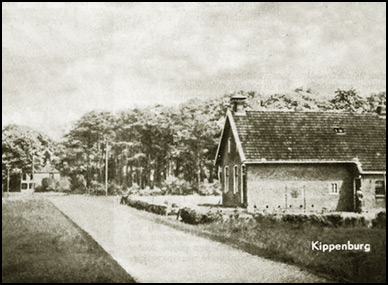 |
|---|
A secondary supply route was used from Sneek, Hommerts Jutryp, Woudsend, Balk via the Wilhelminastraat. At the end of this street was restaurant Teernstra (where a window was damaged) where they went to the right into the Houtdyk to Kippenburg. AtKippenburg the rockets were transferred to the Meillerwagen erector trailer. The rockets were then moved a few kilometers southwest to the launching sites in the Rijsterbos. The deciduous forest was created in the 17th century as a coppice forest by an Amsterdam regent family named De Wildt. They lived in House Rijs. The garden, which was built around the castle, was also adjoining part of the Rijsterbos. Strung over the dark, unpaved, forested lanes of Murnserleane and Middenleane were large camouflage nets suspended high in the trees for further concealment from Allied aircraft. �Balk City Hall Records
The residents of Rijs really had no idea what was going on. Never had so many German camouflaged military vehicles or so many soldiers been seen in their community. Soldiers were seen clearing trees, cutting branches and widening the roads. Brennschluss measuring trucks were located in the meadow of an adjacent farmer's property. Many people guessed the Germans were there because of the nearby IJsselmeer Dam and possible drops of Allied paratroopers, such as the drops that occurred near Nijmegen. It wasn't long before the Rijs citizens learned they must evacuate their homes to make way for German occupiers. About 400 German military personnel were billeted in various locations including: Hotel-cafe Kippenburg and the neighboring farm of Botte Schotanus, Hotel Jans, Hotel Rijsterbos, the villa of the Boerenschool, and in private houses near the Rijs area.

Below: Old city hall building in Balk where rockets were seen uponBattery 444's arrival.
Photos Ed Straten (2000)
 |
 |
 |
 |
 |
 |
|---|

With the V-2 having a maximum range of approximately 200 to 230 miles, it was not possible to target London from the location at Rijs. Instead, Battery 444 turned its attention to East Anglia and the territory surrounding Norwich in eastern England. Kammler was determined to continue the strikes on the British public from wherever possible, even it if meant targeting lesser cities. On September 25 at 18:05 hours, after the trees and shrubs were sprayed with water to lower the fire danger, Battery 444 launched its first rocket toward northern England from Murnserleane. Approximately five minutes later, it impacted at Hoxne in Suffolk. The rocket hit a farm field, inflicting only minor damage to a few buildings nearby. The residents in Balk were shocked at the noise of the launch. On the street it was said it must be the V-2�a large burning thing had risen from the forest and disappeared in the clouds. Everybody was very frightened.
That same day, the rocket troops encountered their first misfire. A rocket had to be drained of its remaining fuel after the engine failed to generate full thrust. The ignition cable was burnt as the engine continued to fire while not leaving the launch table. Upon inspection, it was discovered that the rudders and tail section had been severely scorched, so the rocket was sent back for refurbishing. Closer investigation of other rockets from the Mittelwerk had revealed many additional problems. Bad welds, missing parts, short-circuited electrical connections from inferior soldering�these were just some of the mechanical errors discovered. Not only did the crews face difficulties from the quality of the rockets, there also existed an acute shortage of liquid oxygen. German production had only reached a level of about 200 cubic meters per day, which is only enough to launch 24 rockets. The logistical problems of firing batteries on the move and V-2 units spread out from northern Holland to western Germany did not help matters.

Below: Bridge at Kippenburg. Here was the location of the technical troops.
Photos: Ed Straten (2000)
 |
 |
 |
 |
 |
 |
|---|

On the afternoon of September 30 a V-2 was launched from Murnserleane. It rose to a height of 600 feet before an explosion in the rocket�s tail brought it crashing to earth about 20 yards from the firing table. The alcohol and liquid oxygen tanks exploded upon impact, injuring some of the firing crew. The warhead sizzled in the burning fuel and exploded approximately 45 minutes later, digging a huge crater. This failed rocket had ironically destroyed a small shrine in the forest called Vredestempeltje (Little Peace Temple). Because of failures at Murnserleane, the launch sites were moved a few hundred yards to the roads of Middenleane and Enkuizerlaan. �Henk Koopman, 2001

Below: Entrance to Murnserleane, where many of the V-2s were fired. The Peace Temple sits here.
Photos: Ed Straten (2000)
 |
 |
 |
 |
 |
 |
|---|---|---|---|---|---|
 |
 |
 |
 |
 |
 |

Several weeks later, Wieger Jurjen Draayer, a local farmer, was riding his bicycle along the lanes just beyond the Rijs Forest near Bakhuizen. As there had been strange noises and unknown things seen in the sky for the past several weeks, Wieger was anxious to get home. In the distance he suddenly heard a thump followed by a tremendous roar. The bicycle he was riding came to a stop, and he let it fall to the ground. Racing to a nearby ditch, he peered out to witness a huge steeple-shaped object trailing a tail of fire rising from the forest ahead of him. The object was arcing above him when something went wrong. The noise from the projectile ceased, followed by a whistling as it fell from the sky. There was a tremendous explosion some 70 yards from where Wieger hugged the side of the ditch. Quickly, Wieger got on his bicycle again and started peddling as fast as he could. Tiny bits of material were floating down all around him, almost like snow. He noticed three dead cows in the field near the forest. The explosion left a crater some 20 feet deep and 30 feet wide. As he approached an intersection, a group of German soldiers called for him to stop. The soldiers were surprised to see the farmer riding so close to the V-2 launching area. They asked if he was injured and told him this was a restricted area and to stay away in the future. The dazed and confused Wieger hurried to his home. �Jan Willem Draijer, 2004
For the Dutch residents of the surrounding countryside, it was a very nervous time. Every day they could hear the thunderous noise of the V-2 launches and lived in fear that something might go wrong. As soon as the residents of Rijs saw the white-frosted tankers filled with ice-cold oxygen go by, they knew rockets would be launched again. The farmers soon knew if the rocket did not rise vertically, anything could happen. Failed rockets would fall in the immediate area, sometimes near the residents� homes. Other V-2s encountered problems at higher altitudes, and the farmers watched them plunge into the waters of the IJsselmeer just off shore. For the soldiers ofBattery 444, the stress of the launches was just as great. Many of them would rather have been occupied with some less hazardous job. However, there was plenty of Dutch gin to help them ease their tensions. British fighter planes searched the area several times; however, the ability of Battery 444 crews to launch and retreat quickly made it difficult to spot anything from the air. The Rijsterbos V-2 sites, with very tall trees, provided excellent camouflage; but there was always the possibility of an air attack, and the rocket troops were very wary of this.

Below: Rijsterbos roads Middenleane and Enkhuizerlaan.
Photos: Ed Straten (2000)
 |
 |
 |
 |
 |
 |
|---|

On October 03, marking the second anniversary of the first successful A-4 launched from Peenem�nde, the rocket troops at Rijs fired six missiles toward the Norfolk countryside. Throughout the day, thunderous detonations reverberated at regular intervals. From their homes, the people of Norwich could see huge columns of black smoke in the distance rising high into the air. The strikes were gradually coming closer to the populated sections of the county. Late that evening, an explosion rocked the Hellesdon area. An estimated 400 houses within a two-mile radius were damaged in some manner. The following day British authorities recovered the remains of a V-2, which broke up in the air before impact near Spixworth. The engine and various important parts were sent to Air Institute at Farnborough for analysis. �Robert Collis & Winston G. Ramsey, The Blitz Then and Now Volume 3, 1990
On Wednesday, October 04, 1944, a V-2 fired from Middenleane impacted around 1:45 PM near a school at Rockland St. Mary in Norwich. The blast sent the teachers and students into pandemonium as they were pelted with debris and glass shards. The children were sent home around 2:00 PM while adults surveyed the damage. Along with the school, a number of other buildings had been damaged. Miraculously, there had been no fatalities. The final casually list that day included 23 injured. It was the 14th missile to land in Norfolk over the past 10 days.
Norwich was extremely fortunate given that the city was an infinitely smaller target than London. Battery 444 dropped missiles around the outskirts of the city. V-2s came down at Kirby Bedon, Whitlingham, Horsford, Horstead and Hellesdon. Whether or not the residents of Norfolk knew what kind of weapon was falling near them is debatable. An imposed secrecy by government officials surrounded the new weapon. Civil defense authorities were not informed and this left them baffled as to the cause of the explosions. The first V-2 that fell on September 29 at Ranworth, 15 km North-East of Norwich, was recorded as a plane crash even though the crater was more than 7 meters deep. The confusion persisted even after V-2 strikes at several other locations the following days. �Robert Collis, Jan van Der Veer & Steve Snelling, 1994
After three weeks, Battery 444 disappeared from Gaasterland just as quickly as it had arrived. The last rocket fired from Rijs headed for the port of Antwerp on the morning of October 20. That afternoon at 16:00 hours the majority of the V-2 troops left Gaasterland. A few soldiers and means of transport were left behind, most likely to complete some cleanup work. The columns left via Sloten in the direction of Sneek and comprised a total of 71 vehicles, each driving under its own power. SS General Kammler had ordered the unit back to The Hague following the failure of Market Garden. From September 25 to October 20, Battery 444 launched 69 rockets from Rijs. The first 43 rockets were launched towards English countryside of East Anglia; the others were fired against the port of Antwerp.
Ever since the first rocket was fired from Rijs, British radar momentarily tracked the incoming missiles. In addition, Allied pilots reported sightings of contrails from ascending rockets near Gaasterland. However, these only gave an approximate location of the firing positions. After several weeks, an RAF reconnaissance aircraft brought back a photograph showing clear evidence of activity in the forest. On October 21 a flight of several Tempest fighter bombers of the No. 274 Squadron RAF flew near the Rijsterbos and finally located the launching sites. They flew by heading east, just north of the forest, and after forming up in a line, the aircraft turned back at 5.40 PM to attack the area. They attacked the surrounding houses and buildings. Luckily, farm animals were the only victims of this attack, although some civilians narrowly escaped being hit. It was very ironic that the RAF found the launching sites only an hour after the last Battery 444 vehicles exited the area. The British were unaware that the rocket units were gone, and the bombers returned each of the next few days to attack the forest. By this time, the firing platoons of Battery 444 were arriving in The Hague to join Battalion 485 for operations against London.
Seventy-plus years later, there are still physical reminders of the rocket offensive against Norfolk. A V-2 combustion chamber, which had been converted into a garden ornament, is among a host of relics to have found their way into the Norfolk and Suffolk A viation M useum. The physical scars also remain. The depression in the earth can still be seen at the impact point known as Mud Corner, Crostwick, while at Great Witchingham a crater left by a V-2 has been extended and landscaped. In Shotesham, All Saints, Norfolk, there is a memorial sign marking the crater of a V-2 that impacted on October 06, 1944.
� More information can be found on the History of Gaasterland website �
� The history of the Dendrology of the Rijsterbos �

Below:Shotesham, All Saints, 5 miles south of Norwich stands this marker.

Below: RAF reconnaissance photo over the launching sites at Rijs October 1944. The launch sites were attacked on October 21.


Videos below show the Rijsterbos (Rijs Forest) as seen today.
Special thanks to Ed Straten, Bob Collis and Henk Koopman.
